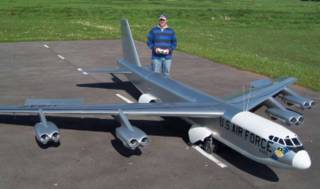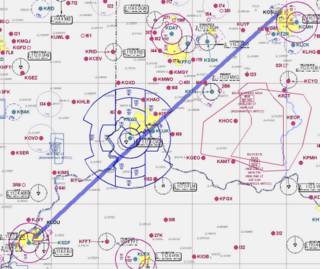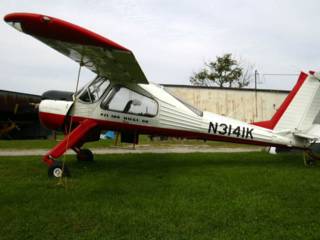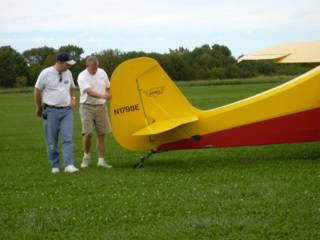Wednesday, September 29, 2004
Videos of the B52 ("Big Buff")
Turn up the sound because those little turbine jet engines really make some noise.
http://www.mcgirt.net/RC/VIDEOS/Giant_B52/B52_flight2.wmv
Video2: BB's final flight
BB takes off, turns to the downwind, tries to turn back upwind, does a split-S straight into the ground.
http://mysite.wanadoo-members.co.uk/duggy/b52.wmv
Its pretty sad what happened to this guy, it's a beautiful plane and you can tell he must have put a couple of years or more into it. Model aircraft flying is tricky, simply because you have to rely just on a ground perspective in order to judge something in flight (you're also physically disconnected from the aircraft, so you loss alot of tactile sensations that can help in maintaining control).
Judging whether or not you're in a properly coordinated turn must be difficult, and when you finally notice that something is going wrong, there might not be enough time to fix it. Fortunately the only causality in a model crash is the aircraft.
Tuesday, September 28, 2004
Cross-Country to Louisville
After this weekend's flight, I decided to start planning for a trip down to
So the plan is to fly down next Saturday sometime in the morning, flight time should be an hour and a half, which is great considering it takes me nearly four hours to drive. NFA's rules say that I'll be billed a minimum of two hours each day if I rent the airplane for a day (or more), I think my actual time will be close to four, so the only other charge I'll have to consider is the ramp fee at Bowman (LOU).
Anyway I'm looking forward to it, should be a good cross-country exercise, and I'll get to impress my family. I'm also going to take my camera and get some shots.
Sunday, September 26, 2004
Fly-out to Red Stewart (40I)
After an admittedly hurried cross-country plan Saturday morning (being a Louisville just recently transplanted to Columbus Ohio, I didn't even have an idea where Waynesville was), I drove down to Don Scott (OSU) to meetup with the club at 10:40am. Ten minutes late, but fortunately I wasn't the last guy there. The only club member I have met before was Doug, who’s really close to getting his private pilot's license, and of course Matt Rousseau who’s the head CFI for the club and also its organizer (really cool guy, one of the reasons NFA is an awesome club).
So we go out to preflight the airplanes, I got N2652T a Piper Cherokee 180, not the plane I usually fly which is the club's Piper Warrior (N84054). Not really much difference between the two planes, both low wing, the Cherokee 180 is faster, but the Warrior is better equipped with an awesome Garmin moving map GPS. The really annoying thing though was in the flight I had a tendency to slip up the radio calls and start off with "Warrior 84...correction Cherokee 26522 Tango.." or some such nonsense, and the "V-speeds" were a little different, so I had a tendency to come in too fast on landings, which made landing rolls a bit longer than usual. Plus Cherokee have these shorter, straight, "Hershey bar" type wings which means ground effect is less on landing. Landing a Warrior you expect a little floating before touchdown since the longer wings allow the plane to ride a cushion of air briefly and if you work it right you can land really soft, but with the Cherokees it's a pretty solid, firm touchdown.
So anyway before I left to do the preflight the president of the club, Dick (he looks a little like Cnl. Sanders) handed me this tin can with an ammeter gauge (it measures the electrical load on system in amps..in planes this tells us if the airplanes electrical system is functioning normally) facing outward on the bottom and a chord with a cigarette light adapter at the end. I looked at Matt and Dick and said "you've got to be kidding," Matt laughed and then told me the 180 had a problem with it's ammeter gauge so they fashioned a backup for about five bucks. :P
I ammeter in hand, I went to preflight the airplane, my flying partner Henry showed up as I was finishing. Henry's about 80ish and Matt told me about him before the flyout. He started flying when he was 25 back in 1957 when he was stationed at Wright-Patterson AFB. We hit it off pretty good, he wasn't comfortable flying since it's been a couple of years for him, so I was happy to be pilot-in-command for the trip, and it felt pretty good having a passenger with a lot of experience. Matt waved us off and me 'n Henry climbed in the plane. I dug out my charts, cross-country navigation log, and the plane's checklist, working through the pre-start and starting procedures.
Okay, starting a plane can be pretty tricky, every much a process as everything else in flying. You work through about seven things before actually turning the key to the mags, then actual ignition is where it gets fun. When you turn the mag or ignition key you have to push the key in as well, and usually with Cherokees you've got to move the throttle back and forth until the engine catches. Well on our 180 I turned the key, pushed it in, worked the throttle like I was taught, but instead of ignition, all I was getting was a humming "eerrrrrrr" sound (which is odd, because before the engine catches the prop usually moves a little and you get a familiar "engine trying to start sound" like in a car). I did a quick check making sure I didn't miss anything in the checklist, the backup ammeter was showing power, fuel pump was on, master switch was on, I primed it, etc. Henry confirmed everything too and we decided to try the mags again, instantly the engine roared to life and I pulled the throttle back down to a sane 1000 rpm. Whew..me and Henry shared a chuckle about the process of starting these damn flying machines and I called got the current weather and called OSU ground to taxi.
We taxied to 27L, did the run-up, everything was great, called Tower telling them we were ready at 27L, they gave us clearance to takeoff, Henry helped me check for traffic (man it's great having a pilot for a passenger ). And away we went, after 500ft off the ground I completed the after-takeoff checklist and proceeded to turn to course.
Strangely I heard a high pitch whistling sound, looking over I saw Henry fiddling with the door, looking up I saw an inch gap where the Cherokee's door didn't latch all the way (the Cherokee and the Warrior only have one door on the right-hand side of the plane, and it has a normal looking car-door type handle and a latch on the top that actually seals the door. Well I noticed during preflight that it took considerable muscle work to fully latch the door.
A door loose in flight in a small non-pressurized light aircraft isn't a big deal, the door doesn't explode open or anything like you see in made-for-tv airplane disaster movies, because the air pressure outside the plane is greater than the cabin (since the air is moving outside) the door stays firmly closed (in fact this what was making it hard for Henry to latch the door in flight, since you need to push it out enough to slam it shut). So other than psychological factor and annoyance (the high pitched whistle of the wind) there's no real emergency. It is distracting however, and after asking Henry what he thinks (to which he replied, it's your call :P) I decided to divert us to Union County's non-towered airport, land, and properly shut the door. Union County was a little out of the way of the course, but I was familiar with it and I could easily find it without too much trouble. We landed, Henry got the door shut, I quickly redid the course, and we took off again.
The rest of the flight down to Stewart was unadventurous, we passed by Wright Patterson and saw a very large military cargo plane pass us off our left wing, and Henry watched for traffic and talked about Wright-Patt while I did the flying and listening. Finding Red Stewart was a challenge, grass fields usually are, but after a couple minutes flying circles in the area Henry pointed it out. After circling around again to get in to a left pattern for the active "runway" (the strip of cut grass lined with orange triangle markers at neither end) we landed and joined the rest of the club (only about ten minutes late).
We met the aerobatics instructor Joe Smith, and he showed us the Decathlon we'd be flying in and basically briefed us on what we would be doing, some emergency procedures and a few Q&A just to gauge our various experiences and what as a group we knew about aerobatics. I volunteered to be the first vict...er...passenger and I was also used as the guinea pig for the parachute briefing.
Joe gassed up the Decathlon (Joe says the way they have to run it for the aerobatics, it's not the most fuel efficient plane on the field, Joe refueled after every ride with us). I climbed in the back (the Decathlon is a tandem two seat configuration), strapped myself in, I mean literally strapped, there's two shoulder harnesses, two lap belts that have to be ratcheted tight, making it a very snug fit. This more than anything brought home the fact in a couple of minutes I'd be upside down 3000 feet in the air. :P
Since this was my first time in a tail wheel plane, and one with a stick instead of a yoke, after Joe took us off and out of Stewart's pattern he handed the controls over to me and I practiced turning, climbing, etc just to get a feel for controlling the plane. Overall I liked the stick, I got comfortable with it quickly, and the Decathlon is very responsive and if you keep it coordinated properly will really handle the way you want. It's strange that as easy as it is to turn (move the stick and there's no delay before it banks) when trimmed for straight and level flight it will stay solid. Joe had me to steep turns, to the left and the right, and while I did great on the left I lost a hundred feet on the right. I later realized why, in normal side-by-side seating configurations the pilot sits on the left, so their perspective to the horizon is different in turns to the left than in turns to the right. Normally for steep turns I "split" the horizon through the middle of the engine cowling, for right turns I place the horizon where it's at the bottom left of my windshield. In the Decathlon the perspective of the horizon doesn't change, so in both left and right turns I should have split the cowling. Doh...
After the turns Joe takes control of the plane and says "I promised some spins, so here we go." A spin is an uncoordinated stall, so to pull a spin off you keep pulling back on the yoke until the wing stops generating lift (we also set the throttle down to idle...but you could also do this full at full power), then right when the aircraft stalls (it'll buffet then the nose will drop abruptly towards the ground) kick the rudder. From the ground you'll see the airplane corkscrewing towards the earth, in the cockpit you'll see spinning ground. Getting out of the spin is pretty straight forward, you point the nose towards the ground (the airplane does that naturally, just loosen up on the stick) and neutralize the rudders (one rudder pedal will be up more than the other, however if you stamp the "up" pedal down all the way you'll just spin in the opposite direction). You're out of the spin when the ground stops moving, then you pull up out of the dive and apply power to start to climb again.
So back to me, Joe and the Decathlon. Now the FAA doesn't require actual spins in training, that is the student doesn't have to demonstrate spins and demonstrate the ability to exit a spin in order to get a license. We do have to be able to explain what a spin is, and the procedure of how to get out of one. Keep in mind this is my first time in a spin ever. Joe pulls back the throttle, pulls the stick up, the stall horn goes off, the plane buffets, he presses the left rudder pedal and the left wing drops. There's a sensation of dropping, like going down the first hill of a rollercoaster, and the plane *almost* feels like it's going to flop over on it's back, before it does though down goes the nose and there's a wonderful view of spinning green and brown ground. After the initial drop the only sensation you get is a sideways tug, although the twirling visual intensifies the effect. After a couple of turns Joe breaks out of the spin, explaining exactly what he's doing while I lightly "ride" the controls to also feel how he's controlling the plane. We climb out (there's plenty of G's when we pull yourself out of the dive, about rollercoaster level) and go back to 3000. Then Joe says "you try"
Well seeing how one goes into a spin and gets out of a spin first-hand is a big confidence boost. So I mimic Joe, a little late with the rudder so my break isn't as abrupt (it's a conflict in the brain, you want to do the move but the other half is going "what are you nuts? don't do that!" so you hesitate on the controls). But the wing drops, the plane spins and I think I actually complete a turn. I was a little surprised how easy it was to stop the spin, just a light press on the right rudder does it, although you've still got to pull back on the stick quickly to stop diving :P). I did another spin and recovery (only half a turn the second time
After spins came the loops, in a loop you have to dive the plane to get up your airspeed (140-150) then pull back smoothly all the way into your lap. The trick with the spins is that people have a tendency to pull to the right, either with the stick or the rudder pedals. Joe had me look over the wing when inverted to keep the wings level, and let the plane's momentum take us back down again. Joe demonstrated a loop and then I performed too. I found the loops pretty easy to do, and pretty friendly (again, a little less than a roller coaster loop).
Next were the rolls, which Joe explained are the most complicated maneuver control-wise. The trick is the rudder pedals, when the plane is on its side, you have to use the rudder control that's "on the top." If the plane is on its left side, you press down the right rudder, on its right the left rudder; also you have to neutralize rudders when the plane is level at the top of the loop. Plus while in a loop you get zero G's, in a roll you pull negative G's. The roll is the maneuver which will lift you out of the seat :P. Which it did, both times Joe performed them, I found myself clutching my lap belt. I didn't perform the rolls, or the hammer-head turns.
We turned back towards the field, and Joe let me take the stick and get us in the pattern and the final, I swung us too wide on the final, but Joe corrected us and made the landing. I felt really good when I was up there, me and Joe joked around and I said every word I could think of to express how awesome it all was. When I got back to the rest of the guys I tried really hard to express that it was great, not a big deal, you'll have fun. However I think I came off as some sort of thrill junkie. :P Doug said he couldn't trust my judgment after I said "the sensations are about equal or less than that of a rollercoaster" temporarily forgetting Doug had said before we started how he hated roller coasters (doh again).
Joe took up another a guy named John (there were three Johns in our club that went down with us :P) while me the other two Johns, Doug and Henry sat around on the benches watched the other planes and talked. Soon we heard a rumbling engine and spotted what Henry identified as a T-28 (since we flew them we took his word for it), the pilot came around and did a low pass flyby over us (I mean right over us, we could see the pilot). We were so dumbstruck we forgot there was Matt’s digital camera right in front of us. After it flew over Doug asked “did anybody get a shot of that?”
When we came back the tail wheel instructor showed up and explained the differences between tail wheel aircraft, specifically the Piper Cub and the Champ verses tricycle gear airplanes like the Cessna 172. An interesting thing to find out was the Cub and the Champ don’t have an electrical system, starting is done by hand propping the engine. Spinning the prop until the engine turns over, there are no radios, no lights, no fuel mixture control. What you have is a stick, rudder, throttle, and carb heat. That’s about as simple as you can get.
I decided not to do the tail-wheel part, the highlight of my day was the aerobatics and I didn’t want to pay the tail wheel time too (the rates are really good down there, the Cub is $43 an hour, instruction is $27). All three Johns went up, Henry flew with Joe doing the aerobatics. He cracked everybody up when he came back, we were joking around that Henry just took over and was doing all the maneuvers himself. When we asked him how it was he just shrugged at us like “yeah about like I remember.”
Doug finally took his turn in the Decathlon, we all cheered him on because he looked really anxious about it. I wanted to get some pictures so I sat closer to the field and snapped photos of the Cubs and other airplanes landing and taking off. It took a while for Doug and Joe to get up in the air, so we just sat out in the shade of a hanger talking. We talked about the NFA, other flying clubs at OSU. I talked with Henry about his flying experiences, it was just a really pleasant day. Doug and Joe got going and about thirty minutes later came back. We all clapped and hollered at them when they had stopped and I noticed Doug seemed to take his time getting out of the plane. I said out loud to one of the Johns, “man is he alright?”
John: “He doesn’t look good?”
Pat: “Nah he looks kinda…”
John: “green..”
It was pretty evident he had the worst time of it all, he didn’t expel anything but he was defiantly unsettled. I felt alittle bit like a tool for running my mouth earlier, and everybody tried to make him feel better like “hey you did it that’s what counts.” It was the truth though and we all meant it, I mean spins are pretty scary. The reason airplane manufactures build planes the way they do is to prevent spins from happening, they were the biggest killer of pilots in early aviation. The spins alone were enough for Doug though, they didn’t do any of the other maneuvers.
About that time me and Henry decided to call it a day and fly back to OSU. I paid for my time in Decathlon, got in the group picture of the event, grabbed some info about aerobatic training and their rates (I really liked the little taste I got yesterday…it would be awesome to compete as an amateur). Then me and Henry said our goodbyes, preflighted the Cherokee and took off. Taking off from a grass, uncontrolled strip is pretty easy, no tower, just taxi, runup and go.
Flying back to OSU was uneventful in comparison to going down, there was one little screw-up on my part though. Soon after we took-off Henry dialed up the Appleton VOR, which is just South of OSU. The course heading I planned and the VOR dial were so close though I decided to follow the VOR (I didn’t check the map to determine if the VOR was in directly in-line with OSU or not). So we followed the VOR, I checked my checkpoints it was going good. Then I missed a point, the city of South Charleston. I could see Columbus in the distance ahead and too the left, which is odd because I was expecting it to be on the right side of my windshield. Henry also noticed something was strange and pointed out Rickenbacker International (an executive airport) and Port Columbus International dead ahead. Hmmm…me thinks we are more South than we planned. Not wanting to get closer to Port Columbus and their Class C (busting their airspace would be BAD). I turned to the North and started looking for OSU, I found it a couple of minutes later, got their weather, called up the tower and reported where I was. They responded and corrected me on my distance (in my initial call up, I reported I was closer to them than I was…Henry guessed they must have had me on radar because they also asked if I was at 3100 ft which I was).
When I got midfield on a left downwind for 27L, I called up the tower again, they cleared me to land and we got down without incident. We taxied back to the NFA tie-downs and me and Henry parted ways (he had to run for a dinner date). I secured the plane up and went home.
It was a great day, I’m looking at the rate sheet for Red Stewart and the Decathlon is $97 an hour. I also heard that they also do a lump sum based on x hours for the aerobatics and refund you back or ask for more money if you go below or over the initial hours they estimate. Next year when I get my credit paid down it’ll be a toss-up between aerobatics and instrument. I was the only guy there that actually talked about aerobatics or emergency maneuver training like it was a fun thing, everyone else seemed to consider it a good thing in general but something you have to force yourself to do. All well.
Clear skies!
















